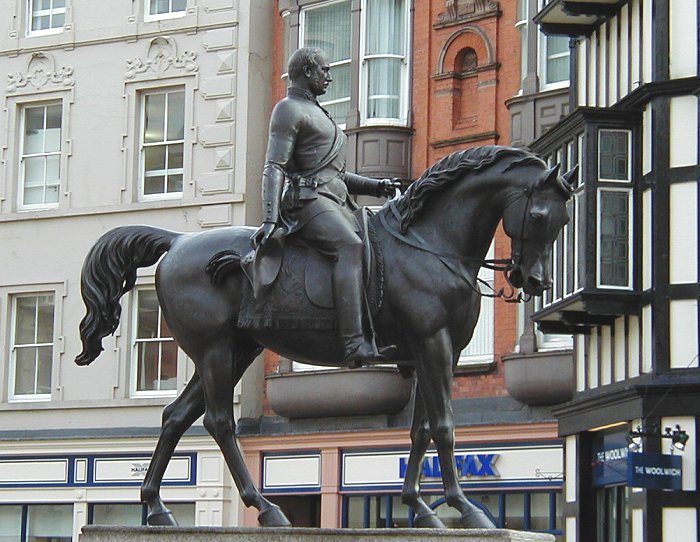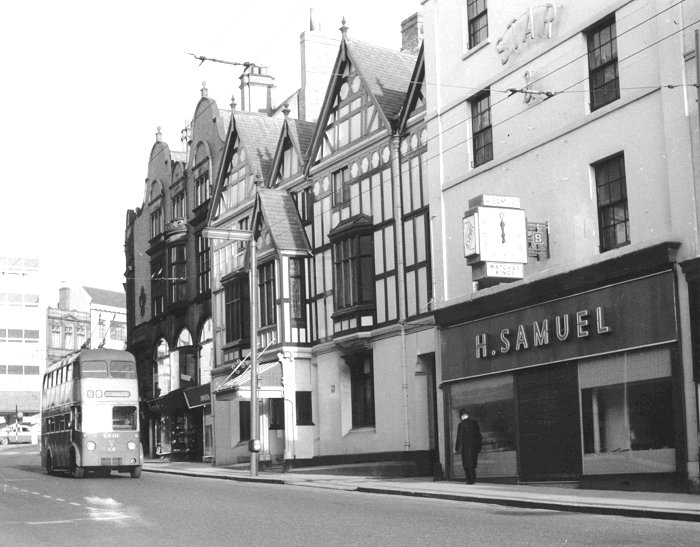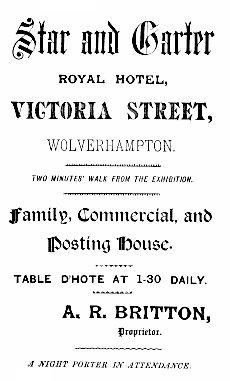The earliest Royal Visits of which we have any authentic record are those of King John, who had a country seat, if we may so term it, at Brewood, at which he is known to have resided during portions of the years 1200, 1206, and 1207. Henry the First is presumed to have visited Staffordshire, as by a charter dated at Cannock, he granted free warren in all his lands at Tamworth and elsewhere to the son and heir of Marmion, whose high estate may be gathered from the words of Sir Walter Scott: "They hailed from Lord of Fontenaye, of Lutterward, and Scrivelbaye, of Tamworth tower and town." In 1251 King Henry the Third visited Lichfield. In 1397 King Richard the Second kept his Christmas in the palace at Lichfield; two years later, namely, in 1399, he was again in the palace, a captive to Bolingbroke, on his way from Chester to London. In the night he attempted to make his escape from a window, but was discovered and recaptured. Baker, in his "Chronicle," says that "they rode on horse-back from Chester to Nantwich; then to Newcastle; from thence to Stafford, and thence to Lichfield, and there rested Sunday; after that they rode forward to Coventry." In the words of Shakespeare alone do we find an adequate representation of the Entry into London : "When rude misgovern'd hands from windows tops, Threw dust and rubbish on King Richard's head." Henry the Fourth, when proceeding against the insurgent Percys in 1403, lay at Lichfield; and advancing thence on July 19th, outstripped Hotspur, who was marching from Stafford to Shrewsbury. The Earl of Richmond, afterwards King Henry VII., having landed at Milford Haven, passed from Shrewsbury through Stafford, Lichfield, and Tamworth, previously to the battle of Bosworth Field. Queen Elizabeth, in her brilliant "progress", immortalised by Sir Walter Scott in his tale of "Kenilworth," went from that splendid demesne to Lichfield, where she remained eight days, and then proceeded to Chartley, thence to Stafford; and after leaving Stafford, through Brewood to Chillington, where she was entertained by John Giffard, Esq., who had been High Sheriff of the County in 1573, and proceeded thence towards Worcester.
James the First passed through the county several times. On his return from his visit to Scotland, in August, 1617 he sojourned a day or two at Tutbury Castle, and the scene of his mother's captivity re-echoed with the wild hilarity of her son and his attendants. From the Parish Register of Alrewas, it appears that he was at Hoarcross on the 30th of August. On the 31st he slept at Lichfield. In 1619 he was again in the county, as shown by an entry in the Parish Register of Tamworth. From the same document it appears that in 1621 King James was at Wichnor, and dined at the Hall there. Charles the First took up his residence at Tutbury Castle whilst on a tour through this part of the kingdom in 1634; he again visited Staffordshire in 1636, and during the Civil War he was frequently in various parts of the country. In the "Itur Carolinum," we find his movements in connection with this county thus mentioned: "October, 1642, from Bridgnorth to Wolverhampton, where he rested three nights, and on to Bremickham, to Sir Thomas Bolt's." During this visit a letter was sent from the King to the Magistrates of "the citty of Leitchfield," directing the inhabitants to send their arms, weapons, etc., to the Royal Standard at Nottingham, dated "Att our Court att Wolverhampton, the 17th October, 1642." On the 15th of May, 1645, we find the King at "Hemley (Himley) near Wolverhampton, Aft. War's." On the 16th, the headquarters of Prince Rupert were at Wolverhampton, and the King lay at "Bishbury, near Sturbridge, Mr. Grosvenor's." On the 16th of June, in the same year, immediately after the battle of Naseby, he marched through Lichfield, sleeping that night in the Close, to Wolverhampton, which he left on the following day. He slept at "Mrs. Barnford's, a widow." On Sunday, the 10th of August, occur s this notice: "Dinner near Wolverhampton, in campis, at Lichfield; supper at the Governor's in the Close; next day at Tutbury Castle". The following narrative is appended to the pedigree of the Coughs, in Shaw's 'History of Staffordshire': "The unfortunate Charles I., during his troubles, slept at Wolverhampton, where he was entertained by Madame St. Andrew, who was either sister or aunt to Mr. Henry Cough, and that gentleman ventured to accommodate their Royal Highnesses Charles, Prince of Wales, and James, Duke of York. An ancient tenement still remains at Wolverhampton, which is part of the house where these princely guests resided. A subscription being set on foot to aid the exigencies of the Royal cause, the inhabitants cheerfully contributed according to their ability, but the most ample supply was expected from Mr. Gough, whose loyalty was as eminent as his fortune was superior, when to the surprise and disappointment of every one, he refused any assistance, 'though strongly urged by the King's Commissioners, who retired in disgust and chagrin.'
When night approached, putting on his hat and cloak, Mr. Gough went secretly and solicited a private audience of His Majesty. He then drew from his cloak a purse containing a large sum of money (by tradition of the family £1,200 is supposed to have been the sum), and presenting it, with due respect, said, "May it please Your Majesty to accept this; it is all the cash I have by me, or I would have brought more." The gift was so acceptable to the King that an offer of knighthood was made to Mr. Gough, but this loyal subject, having no other view than to serve his Sovereign, declined the honour, which was afterwards conferred on his grandson, Henry, of Perry Hall, when he was introduced at the Court of Charles the Second. The scene of this remarkable instance of devotion to royalty is supposed to be the Star and Garter Inn, in Cock Street; in King Charles's time, no doubt, a private house. It was an old but extensive half-timbered house, of the time of the Tudors, or perhaps of an earlier date, and pulled down about thirty years ago. Charles the Second did not visit Wolverhampton. After the battle of Worcester, he rode as hastily as possible to Stourbridge, thence to Whiteladies and Boscobel, in Shropshire, being on the Shropshire side of a lane that divides Salop from Staffordshire. From Boscobel he went down a lane that still exists to Moseley, and from Moseley to Bentley Hall, near Willenhall, which he left as a servant in the train of Miss Lane, for Bristol. In 1687 James the Second visited Lichfield, and lodged at Lady Littleton's house in the Close. In June, 1670, King William passed through the city on his way to Ireland. From this time we have no notice of any visits of Royalty, except some of a transitional character, until we reach the times of the Prince Regent, afterwards George the Fourth, who honored the Marquis of Anglesey with a visit of several days in November, 1815, at Beau- desert. In the year 1832, the Princess Victoria, accompanied by her mother, the Duchess of Kent, arrived on the 24th of October, at Shugborough, the seat of the Earl of Lichfield, the father of the present Earl, who is now the Lord Lieutenant of the County. The tour of the Princess and of her mother had a political character. The Orange party wished to place their Grand Master, the Duke of Cumberland, on the decease of King William, upon the throne, and it was only by a vote of the House of Commons, brought forward by Mr. Hume, that the conspiracy was broken up. The rights of the Princess and the liberties of the nation were in danger, and well do we remember the scene that the drawing room, at Shugborough, presented on the occasion of the Princess (now Her Majesty) receiving a loyal address from the Borough of Stafford.
In November, 1839, the Queen Dowager visited Sir Robert and Lady Peel at Drayton Manor. While staying there she visited Tamworth and Lichfield. Next year, in the month of July, Her Majesty paid a visit to the Earl and Countess of Shrewsbury at Alton Towers. From Alton Towers Her Majesty proceeded to the seat of Earl Howe. On the 28th November, 1843, Her present Majesty and the Prince Consort arrived from Windsor at Drayton Manor, on a visit to the late Sir Robert Peel and Lady Peel. During this visit the Queen and Prince proceeded to Lichfield, and inspected the city and cathedral. In 1852, the Queen, accompanied by the Prince Consort and several of the younger members of the Royal Family, passed through the High Level Railway Station, Wolverhampton, and an address from the Corporation was presented to her by W. Warner, Esq., the Mayor; Her Majesty also graciously accepted a bouquet of flowers from Mrs. Warner. |








